Table of contents
In recent years, headless commerce has become a new emerging eCommerce trend that is often referred to as the evolution of online commerce. In order to take the best advantage of this trend, utilizing a headless eCommerce platform is the crucial step that many online businesses wish to adopt.
In this article, we will look at the best headless eCommerce platforms that can give your business endless flexibility and scalability, as well as how these headless platforms can help you reap the benefits of headless commerce.
What is headless eCommerce
Headless commerce refers to the infrastructure in which the frontend layers are decoupled from the backend eCommerce functionality. Simply understanding, the headless commerce model will separate the storefront layer (the “head”) from the eCommerce platform itself (to make it “headless”).
The headless approach allows two separated layers to work independently and communicate through APIs, which gives you an unparalleled level of flexibility to create a unique and personalized customer experience on the front end. Meanwhile, all the backend eCommerce functionality still remains intact and works smoothly.
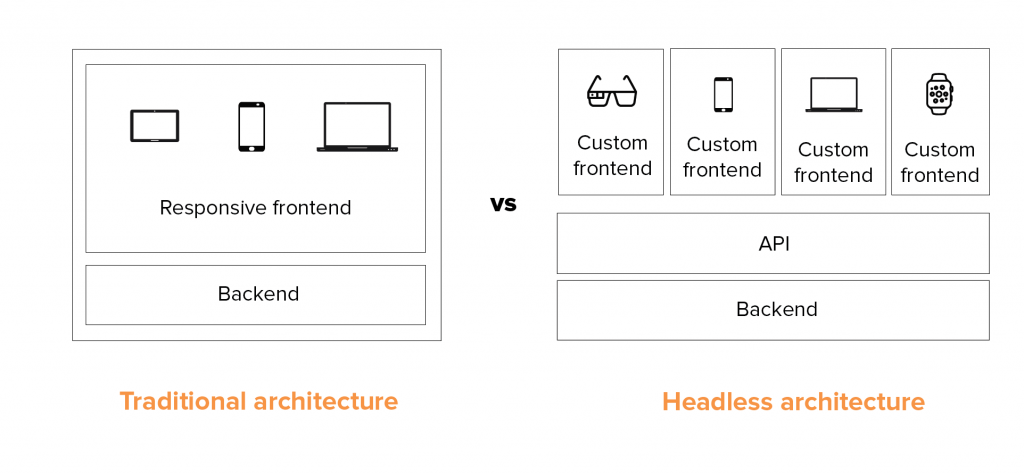
If you are new to this technology, we recommend you some comprehensive articles for a better understanding of headless commerce:
A headless eCommerce platform includes built-in APIs to give you the ultimate flexibility to design your online store for business growth. You can integrate any frontend software and third-party extensions of your choice: CMS, CRM, ERP, ORM, etc., with its commerce backend to utilize the best of both worlds.
Why choose a headless eCommerce platform
Customizability
As a headless eCommerce platform splits frontend and backend into two separate layers, you have endless customization ability to design your online store. You can go with the eCommerce platform that performs all the commerce functionality effectively while also utilizing the favorite frontend solution, be it a CMS, CRM, or a custom solution.
The power to combine the best solution for frontend and backend layers makes it convenient for you to customize your business site to the fullest potential, which hardly could be done with a traditional eCommerce platform.
Scalability
Every eCommerce business owner dreams of going big one day. Going with a headless eCommerce platform will future-proof your brand since APIs allow you to adjust your frontend without the need to replatform the backend when your existing commerce function reaches its limitations.
With API-powered platforms, there’s no need to build a new site from scratch. It’s entirely possible to replace the dated functions and integrate new features as your site grows.
Personalized commerce experience
Personalized commerce is the key to winning customers’ hearts in the fierce eCommerce competition.
Following the headless approach helps you customize a seamless, dynamic, and personalized shopping experience for your visitors. You have full control over storefront design and content management thanks to the frontend flexibility while still enjoying the fast loading speed and seamless performance from the chosen commerce backend.
Go truly omnichannel
Omnichannel and headless commerce make a perfect match since the headless approach allows you to deliver a seamless shopping experience regardless of how customers contact your business.
A headless CMS can optimize content for any device connected via IoT (Internet of Things), such as smart watch or voice shopping. The experience remains the same without any disruption, and customers can enjoy your business in their favorite shopping channels.
Seamless integrations
Want to add rich features to your existing eCommerce store? API-focused eCommerce platforms give you endless integration opportunities to deliver an out-of-the-box shopping experience.
Best headless eCommerce platforms
1. Adobe Commerce (formerly Magento Commerce)
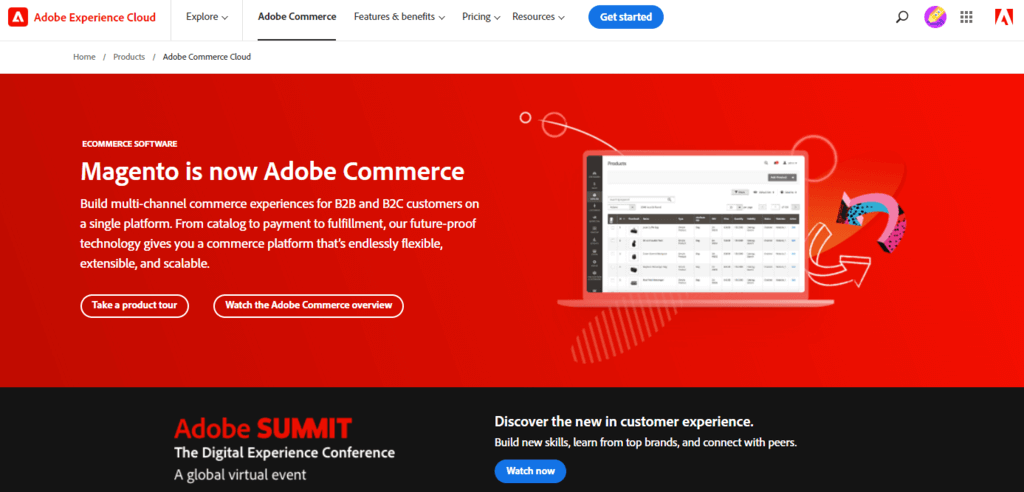
Magento is one of the best open-source eCommerce platforms and is currently ranked third on the list of the most widely used eCommerce websites in the world. This platform is often praised for its powerful built-in features and great customizability.
Magento offers two versions:
- Magento Open Source: completely free for download and installation. However, there is still the cost of hosting, domain, extensions, and development fee if you hire Magento developers.
- Adobe Commerce: the premium version of Magento Open Source. Adobe Commerce suits enterprise-level business with full-featured commerce solutions.
Besides proposing full commerce features for B2B-level enterprises, Adobe Commerce is also an excellent headless eCommerce platform that helps you deliver smooth customer experiences across every channel and device with its powerful APIs included.
Pricing: The pricing starts from $22,000/year based on the company’s revenue.
Pros:
- Complete flexibility to build any custom front-end experience using any technology.
- The same APIs and services are applied for all touchpoints, regardless of technology, thus ensuring a frictionless customer experience.
- Upgrade or innovate on new touchpoints without being constrained or upgrading the backend.
- Separation of frontend and backend development: Changes applied to the frontend code are deployed independently from the backend.
- Build progressive web apps with ready-to-use PWA Studio.
- Take advantage of the commerce integrated tools like Page Builder.
- Endless possibility to integrate with alternative third-party CMS or frontend platform.
>> Read more: Magento PWA Studio Tutorial: The Basics
- Various ready-to-use extensions for maximizing site capability.
Cons:
- Require in-depth technical knowledge to build and manage a Magento headless site.
- Costly and long time to market.
Customer’s site:
Impressed by Magento’s headless solution but are overwhelmed by the expensive pricing? You can always build a brand new Magento 2 website with Magento Open Source as the backend and headless PWA as the frontend to achieve seamless web performance and lightning-fast site speed. Talk to us and we will work it out together!
2. Shopify Plus
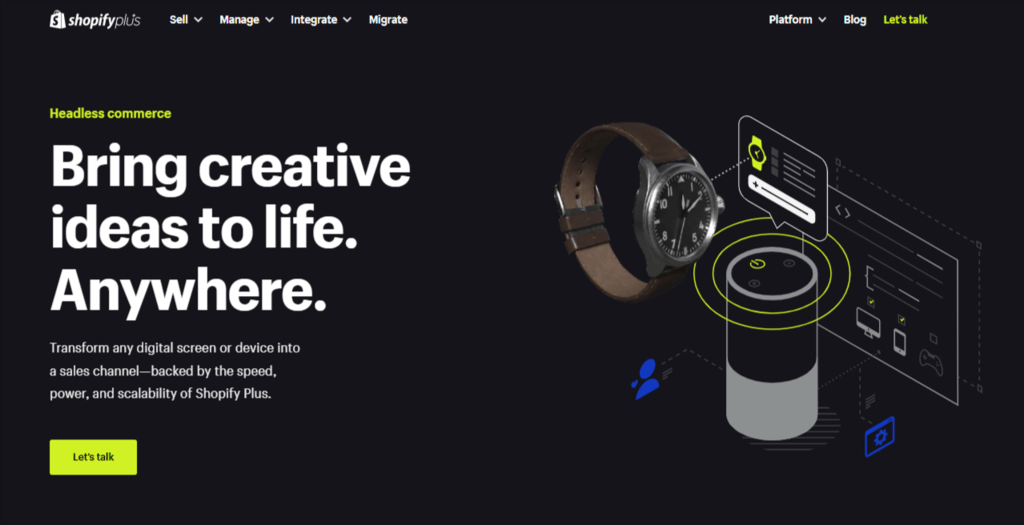
Shopify is the leading SaaS eCommerce platform on the market with more than 1.75 million active merchants. Initially, this platform is well recognized as a hosted solution to help small merchants start their own online businesses. Meanwhile, Shopify Plus is a comprehensive, cost-effective package for middle and large enterprises with advanced commerce features along with endless capabilities and built-in eCommerce automation tools.
Shopify headless solution claims to help you achieve total creative control so that you can build new selling opportunities anywhere – and manage it all from a central location.
Pricing: The pricing starts from $2,000/month based on your sales volume.
Pros:
- Backend powered by Shopify Plus: high-speed performance, omnichannel selling, automated business workflows, ability to scale, etc.
- GraphQL Storefront API ready to design fast, engaging storefronts for web, mobile, and video games.
- Turn any screen into a digital storefront: web pages, mobile apps, smart mirrors, or wearables.
- Integrate with the existing content management system to publish and update storefront content instantly.
- Manage all digital selling channels from a single backend.
- Customize the frontend with an intuitive editor, or access the code directly.
- Seamlessly integrate with third-party frontend tools and systems, such as ERP, CRM, CMS, etc.
Cons:
- Lack of multi-store support: You are unable to manage multi-brands under the same account. Brands managing multiple stores won’t find Shopify Plus as convenient as other platforms, such as Magento Commerce and Salesforce Commerce Cloud.
- Limitations on backend configuration compared to other open source platforms.
- Lack of control over the checkout.
Customer’s site:
3. BigCommerce Enterprise
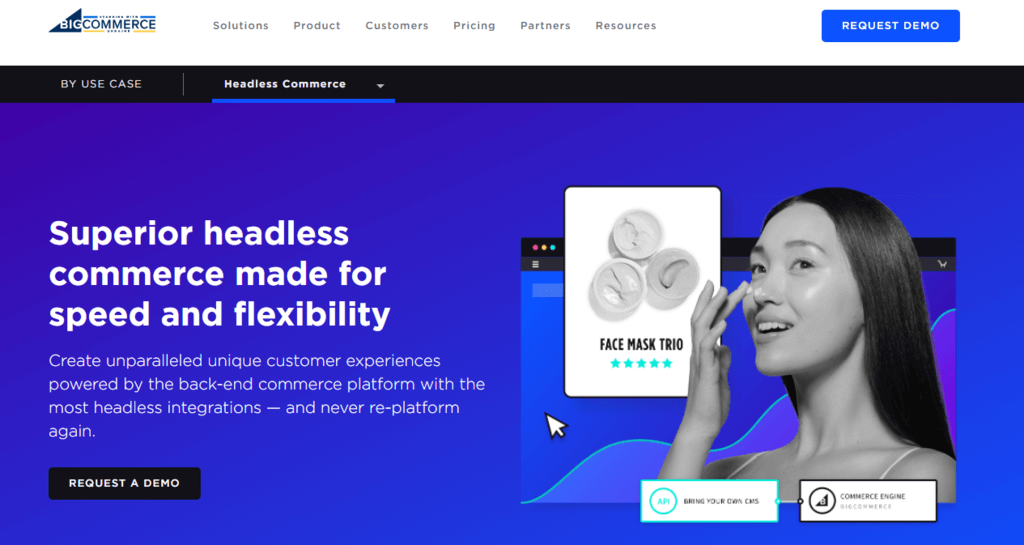
BigCommerce is another prominent hosted eCommerce solution along with Shopify. The platform is packed with all-in-one top commerce features to help businesses build their online presence with ease. BigCommerce Enterprise specialized in enterprise-level brands with the highest level of all BigCommerce commerce features.
BigCommerce headless claims to help you create unparalleled customer experiences that are powered by BigCommerce back-end and the most advanced headless integration. With a wide variety of headless solutions that are ready to be utilized, such as front-end frameworks, CMS, and digital experience platforms, BigCommerce helps you launch faster and customize easier, without the trouble of long-time development.
BigCommerce headless is made for both store owners and developer freedom without starting from scratch. This is the perfect headless eCommerce platform for the combination of content and commerce with the utmost flexibility and customizability.
Pricing: Available upon request.
Pros:
- Sophisticated API architecture to build custom solutions for complex frontend requirements.
- Create and manage multi-storefront for headless storefronts within one dashboard.
- Blazing-fast web performance. Speed to market thanks to static-site generation and server-side rendering.
- Multiple headless solutions to integrate: frontend frameworks, CMS, DXP, ORM, and more.
- Handle up to 600 SKUs per product.
- Out-of-the-box PWA functionality.
Cons:
- The checkout still utilized the BigCommerce domain, which might result in security and authentication issues.
- Require developers and designers to collaborate to build the site at first.
- The development cost is expected to be pricey.
Customer’s site:
4. CommerceTools
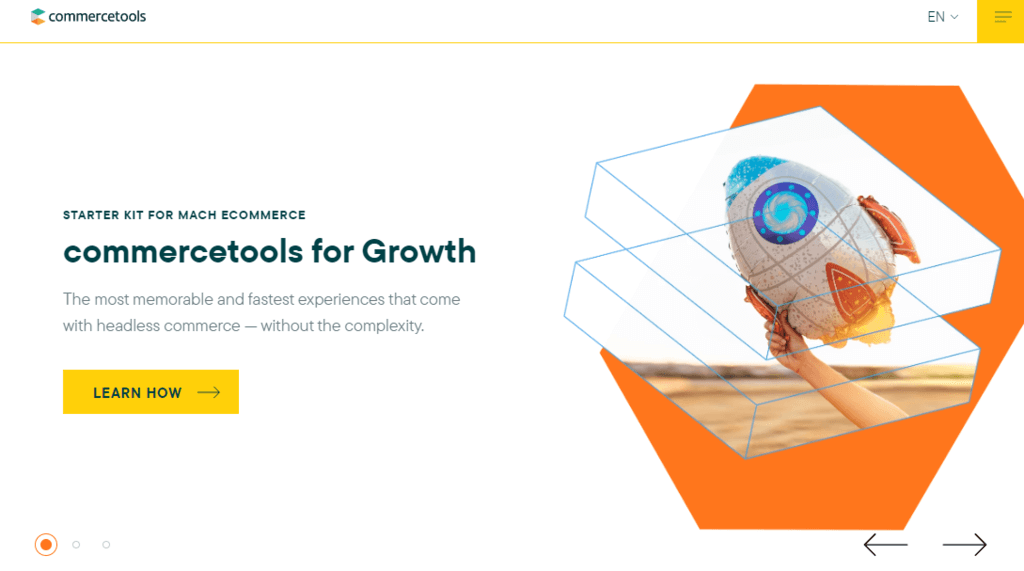
commercetools is one of the world’s leading eCommerce platforms specialized in headless commerce. Based on the modern MACH principle (Microservice-based, API-first, Cloud-native, and Headless), commercetools supports you in building and customizing the commerce solution to tailor experiences to the exact needs of your business and customers.
commercetools provides ready-made commerce building blocks to let you create or supplement your own infrastructure at scale. Plus, the API-first approach allows you to connect commercetools backend to all frontends and third-party applications to achieve unrivaled levels of flexibility.
Pricing: Available upon request. Referentially, the implementation costs start from $300,000, and license fees start from $200,000/year.
Pros:
- Powerful commerce features and functionality: catalog management, unified cart, order management, machine learning, etc.
- Ready-made commerce building blocks to create your own backend structure.
- Manage all sales channels from an intuitive business interface.
- API-first approach: all features and functions are available via open APIs. Connect the backend and frontend seamlessly via APIs.
- Specify how APIs behave. Modify APIs to match unique business requirements.
- Highly scalable and flexible commerce platforms.
- 60-day free trials. No credit card is required.
Cons:
- The pricing is not published so you need to send a quote request.
- Besides API-focused features, other features get less attention and upgrade from providers.
- Lack some enterprise-level features, such as filled level security, sync, and promotion of config across environments.
- A small developer community. It might be hard to find support or answer to some questions.
Customer’s site:
5. Elastic Path
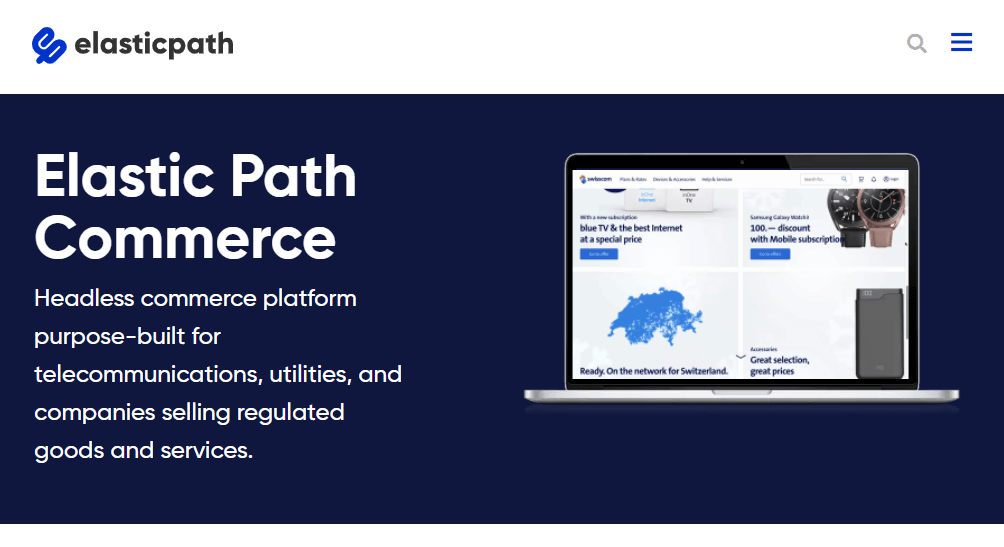
Elastic Path is one of the best open-source software suites that specialize in commerce solutions for enterprise-size business. Its headless eCommerce platform aims at eliminating all the complexity of going headless with a complete, ready-to-launch solution. All the solid functionality of a traditional eCommerce platform is combined with the agility of a headless architecture, resulting in a best-of-both-worlds platform for your store.
Pricing: Available upon request. The cost depends on your transaction volume and your implementation strategy.
Pros:
- Optimized for omnichannel experiences.
- Frontend technology included: PWA, AR experience, Facebook chatbot, Alexa Skill Reference.
- Strong ability to customize.
- Seamlessly integrate with the existing frontend systems: CRM, ERP, POS, and more.
- Flexible cloud agnostic deployment options: deploy on premises or deploy via private cloud.
Cons:
- It’s time-consuming to customize specific business rules.
- The documentation and guideline are not detailed enough for beginners to get started.
Customer’s site:
6. Salesforce Commerce Cloud
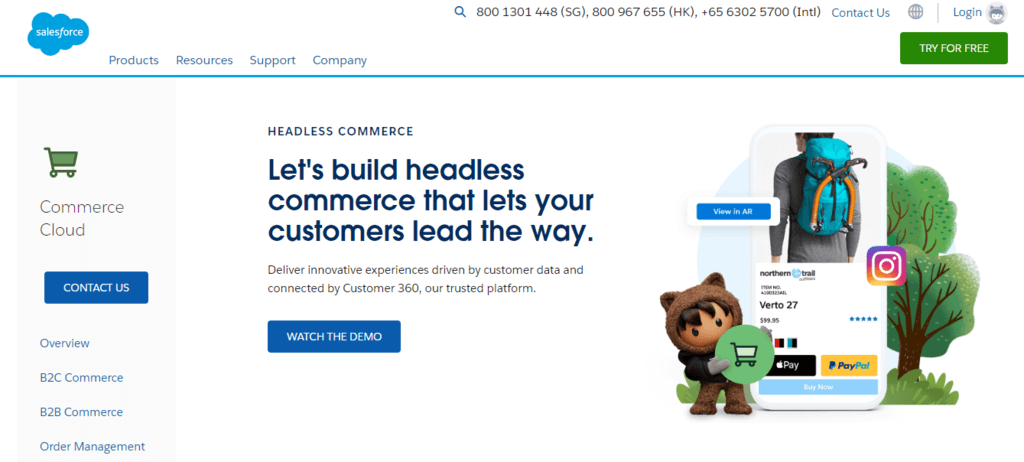
You might have heard of this platform as ‘Demandware’ before it was acquired by Salesforce in 2016. Salesforce Commerce Cloud is a highly scalable, cloud-based SaaS eCommerce solution that provides best-in-class features and functionality for enterprise-level business.
With the aim of erasing the complex infrastructure and expensive hosting fees, Salesforce has introduced a headless approach that lets your customers be the center of your whole business operation. The API-focused approach lets you build excellent frontend experiences while staying flexible with all the backend functionality powered by Salesforce.
Pricing: The price will vary depending on your business model: B2B, B2C, or B2B2C.
Pros:
- PWA kit ready to build mobile-first storefronts.
- Ease to customize storefronts with commerce developer toolkits and templates.
- Headless content delivery network, web application firewall, and security monitoring included.
- Manage millions of SKUs and hundreds of stores from one backend.
- Salesforce Customer 360 platform included to manage customer data across marketing, sales, service.
- Lighting-fast storefront runs on Commerce Managed Runtime.
Cons:
- As the technology aims at enterprise-level companies, Salesforce Commerce Cloud pricing is relatively high, making it an unsuitable choice for SMEs.
- Salesforce functions around its own ecosystem with a variety of apps and services. Hence, it takes time to get over the learning curve.
- There were some complaints about slow customer service.
Customer’s site:
7. SAP
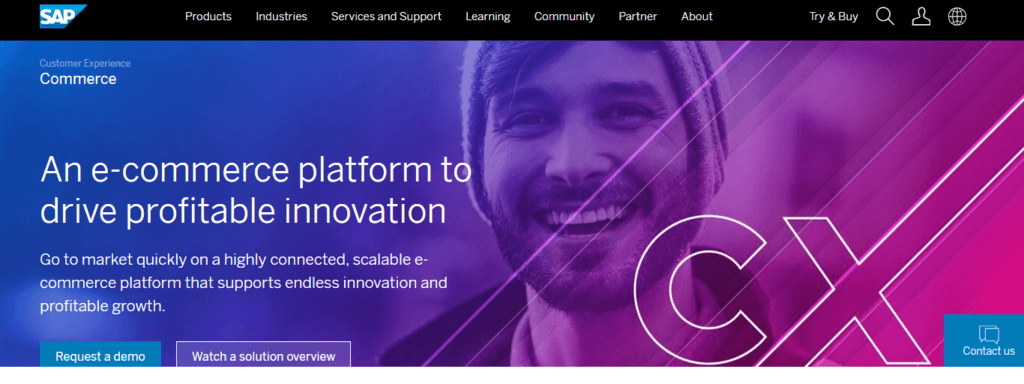
SAP’s reputation has been gained through years of providing high-class ERP systems to millions of businesses worldwide. As a market leader in ERP, SAP software helps all business sizes to centralize data management, thus better managing complex business processes across different departments.
SAP Commerce is SAP’s exclusive headless eCommerce platform that supports innovation and profitable growth. This is a simplified and reinvented commerce solution for both growing and large business.
Pricing: Available upon request.
Pros:
- Integration with a rich partner ecosystem from SAP.
- Easily adopt new customer touchpoints.
- Support multilingual catalogs for global sites.
- Manage multiple storefronts under the same account. Built-in support for multiple touchpoints.
- Embed agility in enhancing customer experience.
- Easy to scale up. Ability to handle a large amount of traffic frequently.
Cons:
- Lack of support compared to other giant eCommerce platforms.
- May require some integration with SAP software to maximize efficiency.
Customer’s site:
8. OroCommerce Enterprise

OroCommerce is an open-source eCommerce platform that is mainly utilized by B2B enterprises, but its comprehensive out-of-the-box commerce features can fit any business model, such as B2B2B, B2B & B2C.
As OroCommerce is built to become the leading B2B solution, it supports both headless and traditional approaches. If you want your B2B business to unify strong commerce backend and third-party frontend software, such as CRM or ERP, OroCommerce will be the perfect headless eCommerce platform you should think about.
Pricing: Available upon request. Referentially, OroCommerce can cost from $45,000/year.
Pros:
- Powerful built-in B2B features: personalized catalogs, promotion management, customers’ corporate accounts, and more.
- B2B-first marketplace management system: self-service portals to streamline both buyer and seller operations.
- Manage multiple storefronts in one panel.
- Integrate with multiple third-party software to enhance business operation: ERP, EDI, PIM, etc.
- Built-in multi-channel customer relationship management to give a 360-degree view of both business and customers.
- An active community with more than 20,000 registered developers.
Cons:
- Coding skills are needed since the platform setup requires complicated programming tasks.
- There are limited add-on extensions. Most of the OroCommerce functions come from its built-in features.
Customer’s site:
9. Spryker

Spryker is one of the prominent open-source eCommerce platforms that aim at providing high-class commerce solutions for mid and large enterprises. Knowing that modern commerce demands flexibility and integrations that are catered specifically to business and customer needs, Spryker embraces API-first architecture and headless approach since the beginning.
Spryker’s Glue API distributes bespoke integrations and services that are tailor-made for each enterprise’s demands. Meanwhile, its LINK Middleware lets you customize the solution to make Spryker work for your needs, rather than changing your system. Therefore, Spryker is one of the most customizable headless platforms that can satisfy all your business requirements.
Pricing: Available upon request. Spryker does not have any plans or editions, but they craft a wide variety of services for different approaches, business models, and business demands.
Pros:
- Flexible headless structure: Ready API to custom your own solutions and frontend integrations.
- Various business models are supported under one platform: Enterprise marketplace, B2B, B2C, and more.
- Strong and comprehensive commerce features to satisfy large enterprises: free hosting, real-time shipping quotes, free site-wide HTTPs, etc.
- Fast deployment: Even large and complex business sites can still go live in a short period of time.
- Exclusive technology to enhance business performance: voice assistance, smart shelves, near-field communication, etc.
Cons:
- It can be burdensome to upgrade and maintain Spryker software.
- The documentation and developer bootcamp is somehow outdated.
- Spryker’s cost seems to be on the pricey side since its solutions aim at big enterprises.
- The Spryker community is relatively small.
Customer’s site:
10. Swell
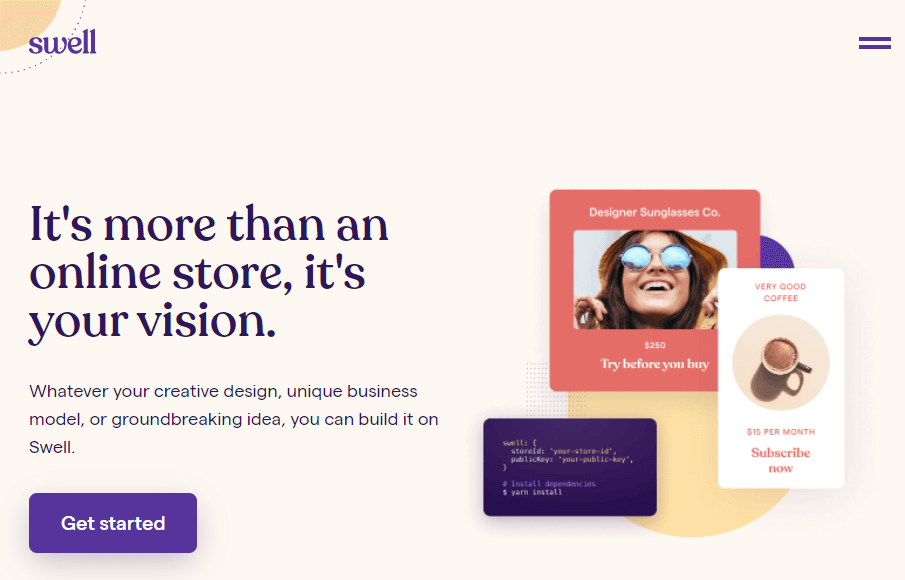
Swell is a growing headless eCommerce platform that is dedicated to building unique shopping experiences without the need for a patchwork of apps. Following the company vision “Headless eCommerce for everyone”, Swell eliminated all the complexity and tedious tasks of creating a creative and dynamic headless store for agencies and startups.
Swell’s API-first approach and headless architecture fuel the powerful commerce performance and generate unlimited design possibilities so that you can build the modern online storefronts without having to code from scratch. Of all the API-focuses commerce platforms on our list, Swell is definitely the most intuitive and user-friendly.
Pricing: There are 3 pricing plans available:
- Community: Free + 2% of sales.
- Standard: $299/month.
- Enterprise: $2,000+/month. Pricing varies based on annual order volume.
Pros:
- Intuitive dashboard for both users and admins. Customizable dashboard for aged users.
- Customize custom checkout flows through APIs to differentiate from other businesses.
- Ready-made stunning headless storefronts themes. Support several frameworks and providers to create and customize storefronts with frontend tooling.
- Fast time to market. Scale effortlessly with Swell’s autoscaling servers and global CDN.
- Easy to get started. The platform is designed for non-technical users centric.
- Affordable headless solution. The pricing is relatively cheap compared to other headless commerce platforms.
Cons:
- There’s no email & chat support for the Community plan.
- Only the Enterprise plan comes with unlimited API limits.
- Lack of documentation and guidelines on how to solve complicated problems.
- Don’t support multi-stores, as Swell is mainly built for small business and mid-market enterprises.
Customer’s site:
11. SpreeCommerce
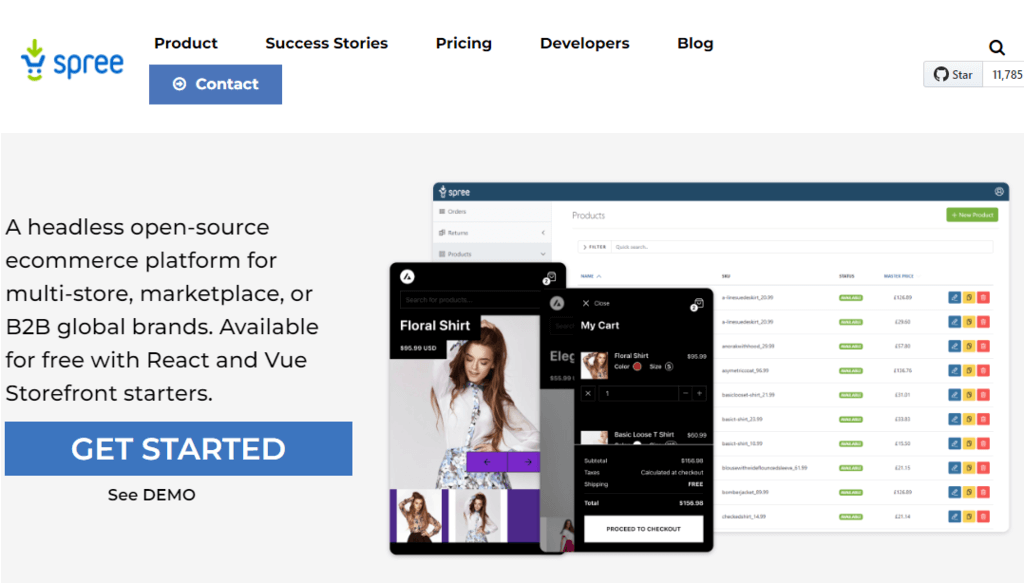
Another well-known open-source headless eCommerce platform specializing in B2B commerce solutions is SpreeCommerce. Its headless approach gives SpreeCommerce the utmost flexibility and customizability that support multi-language and multi-currency global brands to build their dynamic storefronts.
Meanwhile, being an open-source platform in nature also required users to have solid coding knowledge and technical skills to build and customize SpreeCommerce platform to its fullest potential. If you want to run your business without tedious developing tasks involved, Spree also offers Spree as a Service that combines all open-source functionality plus SaaS advantages.
Pricing:
- Spree Open-source: Spree offers the free source code on Github for anyone to download and utilize. Plus, it comes with multiple free extensions to boost productivity and business performance so you don’t hurt your budget for additional features.
- Spree as a Service: The pricing is available upon request.
Pros:
- A completely free headless eCommerce platform for developers with great coding skills.
- Support a wide range of payment gateways, such as Stripe and Authorize.
- Seamlessly integrations with headless storefronts and third-party software.
- Rapid development: it’s estimated that coders using Spree Commerce for online marketplace development write ten times less code compared to other platforms like Magento.
- Build web follows mobile-first approach: compatible with PWA frontend technologies.
Cons:
- Lack of documentation. Some documentation can be updated for newer issues and guidelines.
- Require strong technical skills to develop.
- There’s no support if you utilize its open-source.
Customer’s site:
12. Saleor
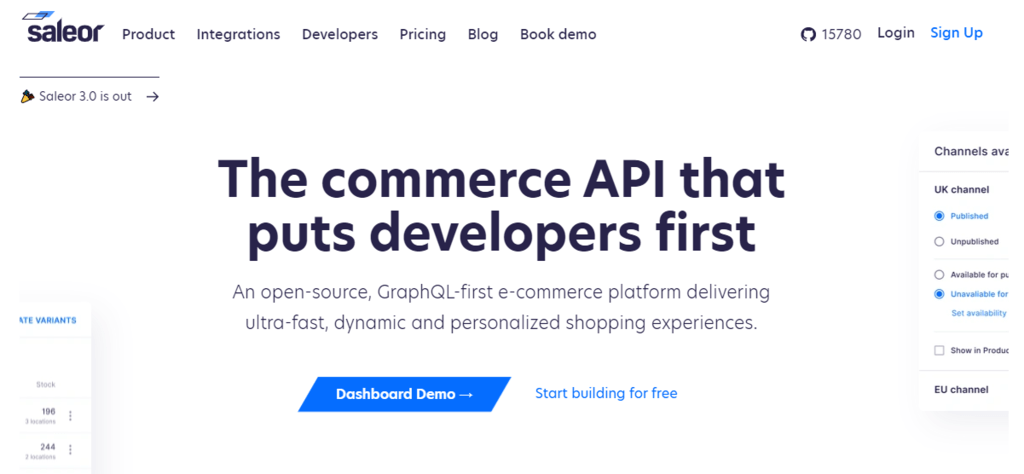
Saleor is an open-source, GraphQL-first eCommerce platform that’s built to satisfy developers first. Aiming at customizing a truly omnichannel experience for eCommerce stores, Saleor utilizes the power of headless to deliver a finely-crafted, flexible and complete commerce package.
With the mission “Made for developers”, Saleor helps you achieve absolute flexibility with GraphQL, JAMstack, Next.js, and modern front-end tools. Plus, there’s lots of room for innovation and experimentation, as you can use their sandboxes to build and test new ideas safely.
Pricing:
- Saleor Open-source: The source code is published on Github. You can download this version and utilize it for free.
- Saleor Cloud: This version functions as a SaaS with open-source benefits. The pricing depends on your monthly orders.
Pros:
- Manage multiple storefronts, apps, and devices from a single back-end thanks to GraphQL API.
- Support multi-channel, multi-warehouse, multi-language, and multi-currency under the same account.
- PWA-ready for an excellent mobile commerce experience.
- Easy integrations with other software: CMS, CRM, PIM, POS, or the future technology.
- Zero maintenance: Saleor takes care of scaling, updating, and securing the infrastructure.
- Control data storage with data centers available in the US and EU.
Cons:
- As this is a developer-first platform, strong coding skills are required.
- This platform is new and developing, so the community is not very active.
- Lack of ready-to-use extensions.
Customer’s site:
Is headless eCommerce platform the right choice for my business?
Given all the advantages that a headless eCommerce platform can provide: flexible development, personalized customer experience, and seamless integration, going headless might be a powerful weapon to leverage your business performance. If you have all the development resources (time and financial) to support a headless transformation, then utilizing a headless platform is definitely the right choice to make.
However, though it might be tempting to follow the headless trend, headless commerce is not a good fit for every commerce store. Depending on the site functionality and level of customization, the pricing for a headless project could range from $50,000 to $500,000, plus the maintenance costs and monthly subscription fees for frontend software.
If your business is doing well enough with a traditional architecture, such as Magento Open Source, consider implementing a PWA Storefront to your existing store could bring you several benefits that often come with a headless site:
- Blazing-fast and smooth site performance
- Stunning UX/UI design
- Responsive frontend across devices
- App works when offline
Don’t hesitate to contact us to see how we can help leverage your current business with a headless PWA!
>> Read more: Best Open-source eCommerce platforms
FAQs
Traditional commerce is often referred to as a monolithic or all-in-one commerce solution. All the functionality required to run an online business, such as displaying UI layer, managing & publishing content, are tightly coupled together. Therefore, even a small adjustment to the UI design can severely affect the whole system, which results in limited customization possibilities. Headless commerce was born to solve this situation.
A headless eCommerce platform functions similar to a normal eCommerce platform but with an API-focused approach. It separates the frontend from its backend and connects them through APIs, thus it gives you the ability to integrate the commerce backend with any frontend system you want to, such as CMS or ERP.
A headless CMS resembles the same headless architecture where the content is delivered via APIs for seamless display across different devices. Many business owners choose to integrate headless CMS with their current website to deliver content in a more dynamic and personalized way.




